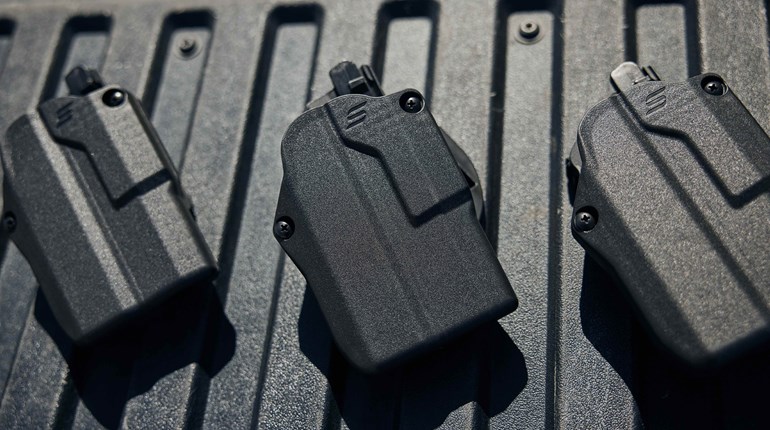
If there’s such a thing as a “blah, blah, blah” filter, we need one—or our present version needs a serious upgrade. Either way, any reduction whatsoever in the “it’s just a different-colored 19X” blather will be welcome: Glock’s newest model has a number all its own for good reason.
We’ll concede the confusion isn’t altogether incomprehensible: The new G45 Gen5 is of the same caliber (9x19, or 9 mm Luger) and possessed of quite similar overall dimensions to the 19X—most obviously, a G17-length grip matched up to a G19-length slide. The two also share like internals, but that can be said of all the Gen5S: The Marksman barrel, an improved trigger system adapted from the design first fielded in the G42 and G43, changes to the firing pin and block, fully ambidextrous slide stop/release, swappable magazine release, and a new locking block/pin configuration are present in both models, as is the lack of front strap finger grooves. Four interchangeable back straps (two with a beavertail, two without) round out the pair.
Beyond that, though, the notion of “cosmetic only” differences is simply wrong. True, the G45 dons the NDLC finish (highly scratch- and corrosion-resistant, high-lubricity “diamond-like carbon”) of the other Gen5S. It’s pretty much everything Glock claims for it: We have MSR bolts protected with a very similar process, and the finish is tougher than the underlying steel. Thus far, the G45 slide is holding up with the same ferocious aplomb against our Kydex assault. The 19X, in contrast, uses a tannish “coyote” PVD finish on the slide, matched to similar-colored polymer below. Not exactly subtle on the belt (and rumor has it that law enforcement asked for all black to be restored for duty use on the G45), but not without its own advantages. The PVD doesn’t show a mark after hundreds of holster/draw repetitions, either.
Where 19X color meets an actual difference with the G45 is unexpectedly substantive, though with comparative pluses and minuses in both pistols. The lower rear opening in the grip that has been extant on all previous Gens is plugged with a (removable) lanyard loop fitting in the 19X. Most folks won’t think they need this arguably anachronistic accouterment (don’t forget, it is there because the X was submitted for the military’s Modular Handgun System contract), but the part has a benefit that isn’t all that subtle: There’s no way to get a reload jammed against the lower edge of the interior “web” that forms the back of the magazine compartment in all Glocks. The extractor groove of the top cartridge in your magazine slides right on by. The coyote color of the grip interior is a plus, too: If you’re looking for your reload as we’d urge, you won’t be looking into a black hole. Point and point, 19X.
Whatever the black polymer G45 gives up in terms of seeing the inside of the magazine well on a reload, it steals ahead of its crossover cousin in overall target dimensions for that reload. With a flare—numerically and literally—that matches the rest of the Gen5S, the G45 boasts a magazine opening that’s nearly 10 percent larger (based on rectangular approximation borrowing from the Riemann sums technique). In one of those odd marketing twists, the folks at Glock seem as proud of the G45 flare for “improved shooting comfort” as they do for speedier reloading. ok by us, but we’re more impressed with the latter.
When range time came around, G19X experience was a welcome benchmark. Both pistols readily demonstrated the bona fide accuracy improvements of the Marksman barrels with a wide range of bullet types and weights. We knew from our 19X experience not to judge the 5.5-pound trigger press of the out-of-the-box G45 too harshly, and it slicked up rapidly to just over 5 pounds. The reset is delectably shorter, and Gen5 typical: just plain better than all the earlier Gens.
Our sample also arrived with a prejudice-confirming pair of Glock-specific AmeriGlos that feature a favorite and extremely versatile sight configuration (see Nuts And Bolts). With quality ammunition and good trigger manipulation, just about anything inside 50 yards was eminently hittable, and a Labradar chronograph showed trivial velocity losses when compared to both a G17 and G34. Ample grip area keeps it incredibly controllable even with heavy-recoiling defensive ammunition, while a shorter slide grants additional maneuverability and reduced weight without conferring the “bucky” nature so objectionable in other handguns that shrink toward a better carry coefficient.
The final obvious change in the G45 pushes into mostly new territory, and was signaled by the “FS” designation of our trial gun. In this case, those seemingly innocuous letters stand for “front (cocking) serrations.” While they’re short of clouds parting and heavenly choruses, they’re incredibly welcome. We know that substantial schools of thought say they are unnecessary, but we beg to differ. Not only does the slicker NDLC finish prove them a good idea, but we’re fans of anything that makes fully in-control manipulation of the slide surer, and therefore safer, especially for those with smaller hands and less upper body strength. (More “FS” pistols are in the offing—see “First Gear” on page 48.)
Good looks, splendid manners and a truly great feature mix—both new and vintage—put us in a spot with the G45. It begs those “20/20 hindsight” sort of questions, but there seems no point with the G45 now in hand. Such musing tends to overshadow the value of the journey with the charms of the destination, and it took a steadily improving chain of Glock 17S and 19S to get us to the G45 after all.
It’s too early to say the G45 is the best all-around Glock yet, but tempting just the same.
Nuts And Bolts
Magazine Well – The Gen5 Glocks have been oddly, stridently criticized in some circles for the “half-moon” relief cut in the bottom of the grip front strap. Most objectors seem to decry the cut’s truly tiny reduction of grip real estate, and Glock has obligingly removed it.
This clearance was originally intended to give extra purchase on the long-nosed baseplate magazines introduced in Gen5 as an aid to magazine stripping in the reduction of Type 3 malfunctions. The cut is absent on the G19X, which in fact went the other way with a G26- and G27-like front strap extension that was well-thought-out in terms of preventing certain other handling miscues. A reasoned case can be made for either.

We wonder how long the absence of the half-moon will seem like a good idea, however, and here’s why: Another subtle change in the Gen5 has thickened the “web” that forms the back of the magazine well inside the grip. Long possessed of a half-moon scallop of its own, this relief made it comparatively difficult to catch the extractor groove of the top round of a charged magazine, and, depending on how forceful your reload, could either lock up magazine insertion briefly, or strip the magazine right out of your hand. The issue was always more apparent on larger-caliber Glocks because their cartridges had larger extraction grooves. Aftermarket “plugs” were a welcome solution, and even the 19X’s lanyard-loop version neatly circumvents the problem.
But as much as we love the flare/magazine well, the lack of the front half-moon makes Type 3 clearing tougher than it’s ever been on a Glock. The flare leaves the sides of magazine baseplates very chancy to grab. The only remaining spot for authoritative grasping is now with the thumb vertically on the rear magazine wall, which will be inconveniently (disastrously?) occluded if you try to eliminate the extractor groove hang-up with a plug. Worse, if you used a slight front-to-back angulation to stay clear of the web, you’ve surrendered clearance for the top round’s bullet nose at the front of the magazine well. Collision and delay are again the result.
It will be interesting to see if another rethink occurs, but there is a silver lining: Type 3S remain astonishingly uncommon on all generations of Glocks, especially in the dual recoil spring inhabitants of Gen5.
Sights – Conventional “notch and post” sights on the E.E. Patridge pattern have had many useful up-techs in the last few years—fiber optics and tritium lamps, among others. But few are more unexpectedly excellent than their pairing with large, brightly colored dots on the front blade. This advance was essentially stolen from another, less obviously Patridge pattern: so-called “express” sights. Widely popularized on large-caliber hunting rifles for dangerous game, their speed is well documented, especially when combined with the inherent “pointability” of long arms. The shallow rear notch of the type has been less successful in the handgunning world, especially as the length of a shot grows. But with a more conventional notch, the big front cue solves a lot of problems, particularly if your peepers aren’t what they once were.
In a very rare nod to a third party, a slope-sided (eye-drawing and snag-resistant), close-to-the-slide, Glock-specific AmeriGlo is available as an orderable option on the G45 (and many other models, too). Our advice is emphatic—give a set a chance. Much as we love the super-bright advent of fiber optics, we’re slowly trading out to larger dots on most every handgun. It’s true that fiber is brighter by a margin in daylight, but the size difference more than compensates. They’re also considerably more rugged than most fiber configurations.
The AmeriGlos have another not-so-subtle value add, too: Appropriately subdued mountings of tritium lamps will give you low-light alignment capability that utterly eludes the bulk of fiber setups. Importantly unlike earlier tritium enhancements, these won’t become muddy, uncleanable, distracting smudges over time. A couple hundred rounds out, most shooters find them easily ignorable in bright conditions, but reassuringly precise when things go “bump” in the night.
Frank Winn has been studying arms and their relationship to tyranny, meaningful liberty and personal security all his adult life. He has been a firearms safety/shooting instructor for more than 20 years, earned state, regional and national titles, and holds Master or Grand Master rank in several competitive disciplines.


































